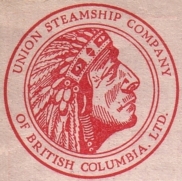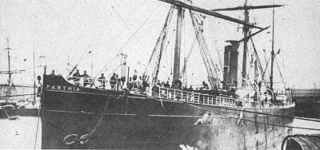
A steamship, often referred to as a steamer, is a type of steam-powered vessel, typically ocean-faring and seaworthy, that is propelled by one or more steam engines that typically move (turn) propellers or paddlewheels. The first steamships came into practical usage during the early 1800s; however, there were exceptions that came before. Steamships usually use the prefix designations of "PS" for paddle steamer or "SS" for screw steamer. As paddle steamers became less common, "SS" is assumed by many to stand for "steamship". Ships powered by internal combustion engines use a prefix such as "MV" for motor vessel, so it is not correct to use "SS" for most modern vessels.

Sir Hugh Allan was a Scottish-Canadian shipping magnate, financier and capitalist. By the time of his death, the Allan Shipping Line had become the largest privately owned shipping empire in the world. He was responsible for transporting millions of British immigrants to Canada, and the businesses that he established from Montreal filtered across every sphere of Canadian life, cementing his reputation as an empire builder. His home, Ravenscrag, was the principal residence of the Golden Square Mile in Montreal.

APL, formerly called American President Lines Ltd., is an American container shipping company that is a subsidiary of French shipping company CMA CGM. It operates an all-container ship fleet, including nine U.S. flagged container vessels.

RMS Segwun is the oldest operating steam driven vessel in North America, built in 1887 as Nipissing to cruise the Muskoka Lakes in the Muskoka, Ontario, Canada, a resort area with many lakes and rivers. Early in the 20th century, Muskoka was poorly served by roads. Vacationers were transported to lodges, or private cottages, via a fleet of steamships. Segwun is the oldest of only three ships in the world still carrying the status of Royal Mail Ship, and the only steamer.

CP Ships was a large Canadian shipping company established in the 19th century. From the late 1880s until after World War II, the company was Canada's largest operator of Atlantic and Pacific steamships. Many immigrants travelled on CP ships from Europe to Canada. In 1914 the sinking of the Canadian Pacific steamship RMS Empress of Ireland just before World War I became largest maritime disaster in Canadian history. The company provided Canadian Merchant Navy vessels in World Wars I and II. Twelve vessels were lost due to enemy action in World War II, including the RMS Empress of Britain, which was the largest ship ever sunk by a German U-boat.

Ellerman Lines was a UK cargo and passenger shipping company that operated from the late nineteenth century and into the twentieth century. It was founded in the late 19th century, and continued to expand by acquiring smaller shipping lines until it became one of the largest shipping firms in the World. Setbacks occurred through heavy losses to its merchant fleet in the First and Second World Wars but were overcome in each case.

SS Abyssinia was a British mail liner built in 1870, and originally operated by the Cunard Line on the Liverpool–New York route. She later served the Guion Line on the same route and the Canadian Pacific Line in the Pacific. In December 1891, Abyssinia was destroyed mid-Atlantic without loss of life by a fire that started in her cargo of cotton, further highlighting the danger in carrying both cotton and passengers on the same ship.

Furness Withy was a major British transport business. It was listed on the London Stock Exchange.

The Union Steamship Company of British Columbia was a pioneer firm on coastal British Columbia. It was founded in November 1889 by John Darling, a director of the Union Steamship Company of New Zealand, and nine local businessmen. The company began by offering local service on Burrard Inlet near Vancouver and later expanded to servicing the entire British Columbia coast.

Komagata Maru was a cargo steamship that was built in Scotland in 1890, was in German ownership until 1913, and then had a succession of Japanese owners until she was wrecked in 1926. She was launched as Stubbenhuk, renamed Sicilia in 1894, Komagata Maru in 1913 and Heian Maru in 1924.

SS Statendam was a transatlantic ocean liner that was launched in Ireland in 1898 for Holland America Line. She was the first of several ships in the company's history to be called Statendam. She was NASM's first ship of more than 10,000 GRT, and she was the largest ship in the company's fleet until Potsdam was completed in 1900.

Captain Alexander "Sandy" Allan, was the Scottish sea captain and businessman who founded the Allan Shipping Line in 1819. Rising from shoemaker to shipping magnate in little more than thirty years, Allan retired in 1839 having made a fortune and created a transatlantic dynasty. He is recognised as one of the major contributors to Scotland's commercial interests in the early 19th century, and to the establishment of the Firth of Clyde as an international centre of shipping. During the Napoleonic Wars his brig Jean – so named for his wife – held the record for the fastest crossing between the Firth of Clyde and Quebec City. Under his five sons, the Allan Line became the world's largest privately owned shipping empire.

Andrew Allan was a Scottish-born Canadian businessman and financier. In 1882, he succeeded his brother, Sir Hugh Allan, of Ravenscrag, in the Allan family's Canadian enterprises that were centred on the Allan Line Royal Mail Steamers, but also included banking and railways. He was Master of Foxhounds for the Montreal Hunt.

SS Parthia (1870–1956) was an iron-hulled transatlantic ocean liner built for the Cunard Line by William Denny and Brothers in Dumbarton, Scotland. Her sister ships were the Abyssinia and Algeria. Unlike her two sisters, Parthia was smaller, built in a different shipyard and had a slightly different funnel arrangement. The Parthia was retired by Cunard in 1883 and sold to John Elder & Co., who subsequently transferred her to the Guion Line. After serving with the Guion Line and operating on trans-Pacific routes with the Canadian Pacific Railway Company, she was refitted and renamed Victoria.
The Green Star Line was an American steamship shipping line created in 1919 and operated until 1923. Established by Irish businessmen as a response to the Shipping Board's campaign urging Americans to buy ships for wealth and patriotism during and after World War I.

The Falls Line was a Scottish shipping line in the late 19th and early 20th centuries. The line operated ships of two companies; Wright, Breakenridge & Co. and Wright and Graham & Co.. Both companies' ships used the same flag. The Falls Line does not appear to have operated ships after 1914, although some of the company's ships continued in operation for other owners.
SS Baltimore was an iron passenger steamship of the North German Lloyd line, built by Caird & Company of Greenock, Scotland in 1867. She was used for most of her career to bring German immigrants to Baltimore.

SS Grampian was a transatlantic ocean liner that was built in Scotland in 1907 and scrapped in the Netherlands in 1925. She was operated originally by Allan Line, and later by Canadian Pacific Steamships. In the First World War she remained in commercial service but carried Canadian troops. In 1919 she survived a collision with an iceberg. In 1921 she was gutted by fire while being refitted. The refit was abandoned, and in 1925–26 she was scrapped.

A. H. Bull Steamship Company was a shipping company and passenger liner service founded in New York City in 1902 by Archibald H. Bull (1848-1920). Service started with shipping between New York and Florida. His fleet of ships then added service to other Eastcoast ports. The company is also often called the Bull Lines and the Bull Steamship Line or A. H. Bull & Company. While founded in New York, Bull soon move its headquarter to Peir 5 in Baltimore, Maryland. Bull Lines main Eastcoast ports were: Baltimore, Charleston, Philadelphia, Tampa and Norfolk, Virginia. Oversea ports: Porto Rico, Antwerp, Bordeaux, Hamburg, Bremen, Copenhagen, and West Africa. Bull Steamship Line supported the US war effort for both World War I and World War II, including the loss of ships.

Merchants and Miners Transportation Company, often called M&M and Queen of Sea, was a major cargo and passenger shipping company founded in 1852 in Baltimore, Maryland. In 1852 is started with routes from Baltimore and Boston two wooden side wheelers ships. In 1859 M&M added two iron hulled steamers to its fleet. In 1866, post Civil War, M&M added routes to Providence, Rhode Island, Norfolk and Savannah, Georgia. In 1876 M&M purchased the Baltimore & Savannah Steamship Company add routes to Savannah, Jacksonville and Charleston. In 1907 the Winsor Line of Philadelphia's J. S. Winslow & Company of Portland, Maine was purchased, with seven steamships. The Winsor Line was founded in 1884 by J. S. Winslow. The Winsor Line first route was from Norfolk, Virginia to New England ports, supplying West Virginia coal. The Winsor Line sailing ship Addie M. Lawrence took ammunition to Europe during World War I. By World War II M&M had a fleet of 18 ships and add routes to Miami. With the outbreak of World War II the War Shipping Administration requisitioned Merchants and Miners Transportation Company fleet of ships for the war effort.























